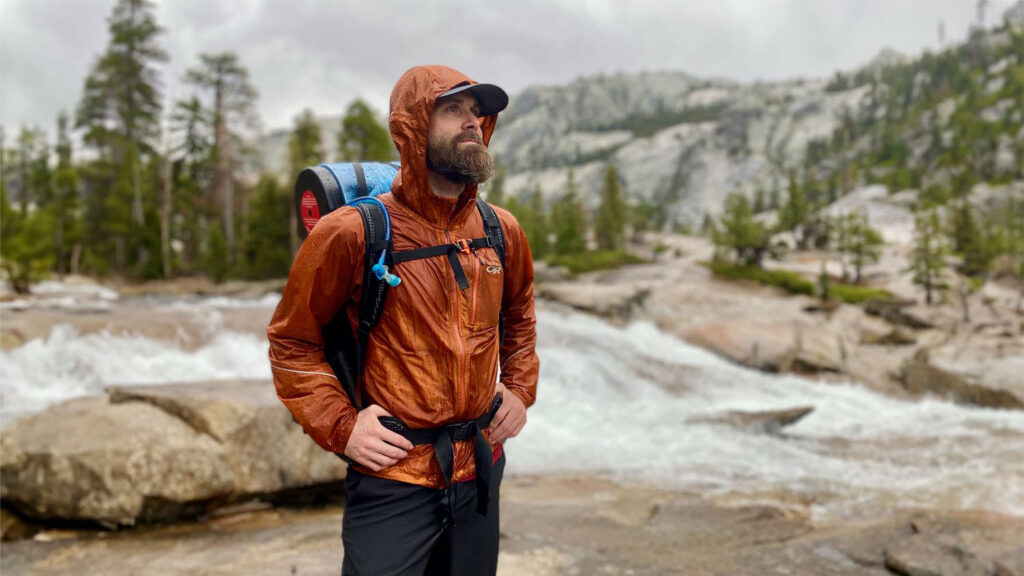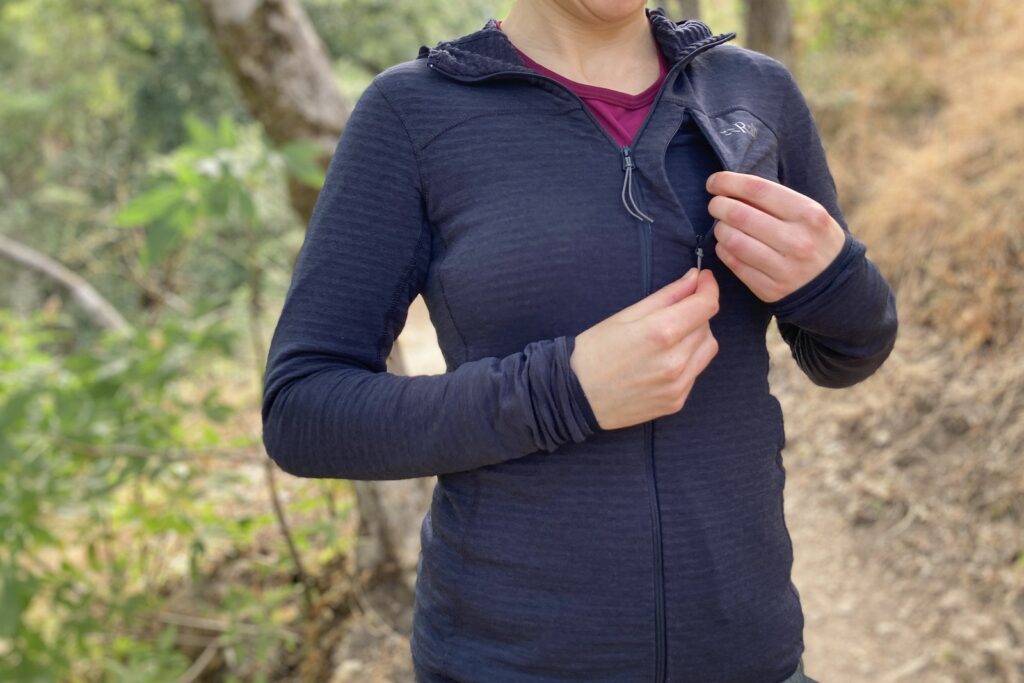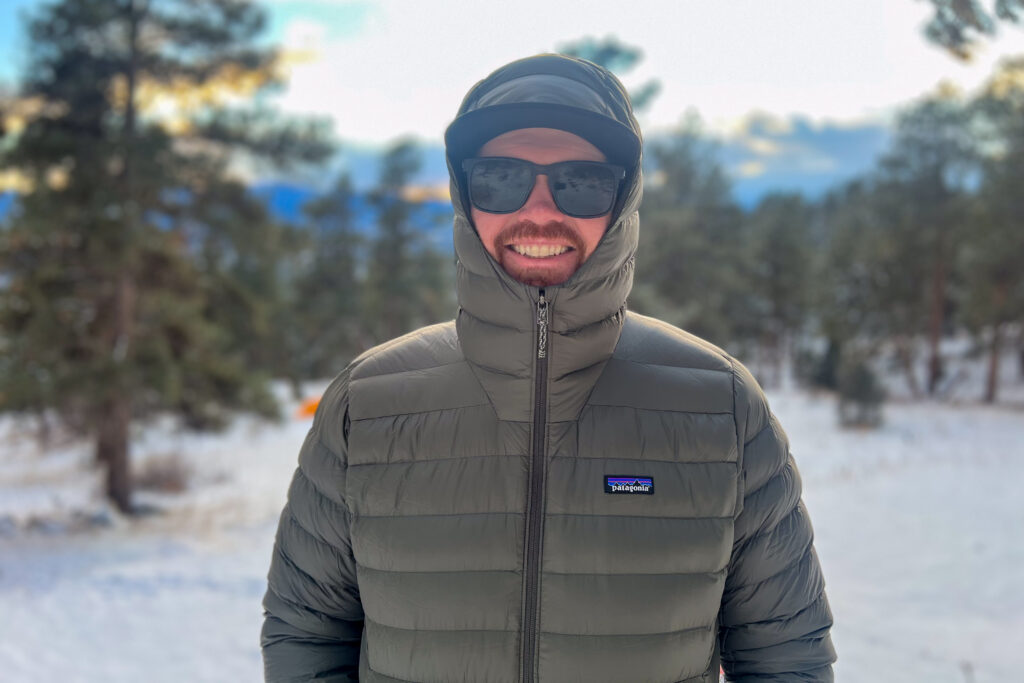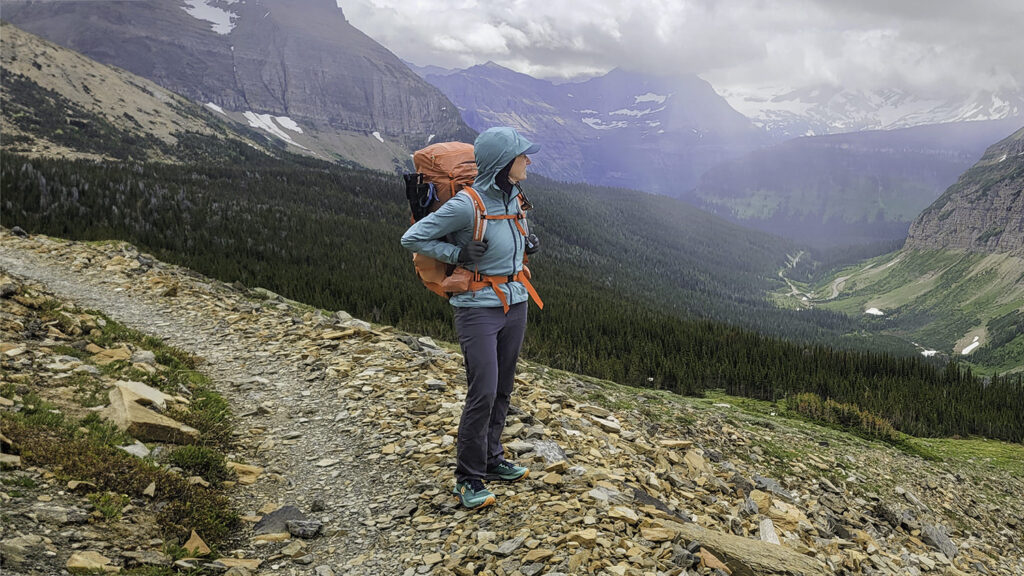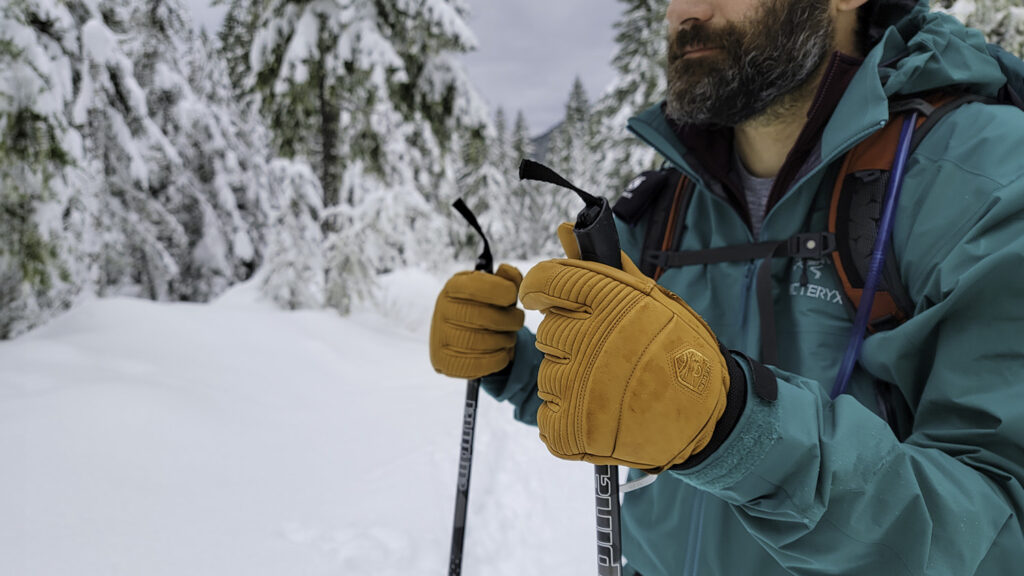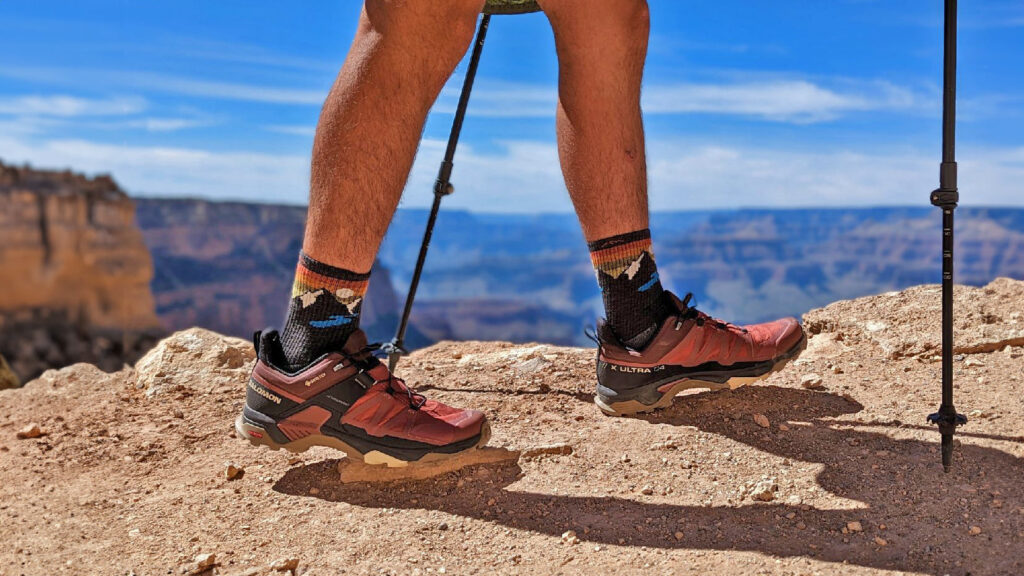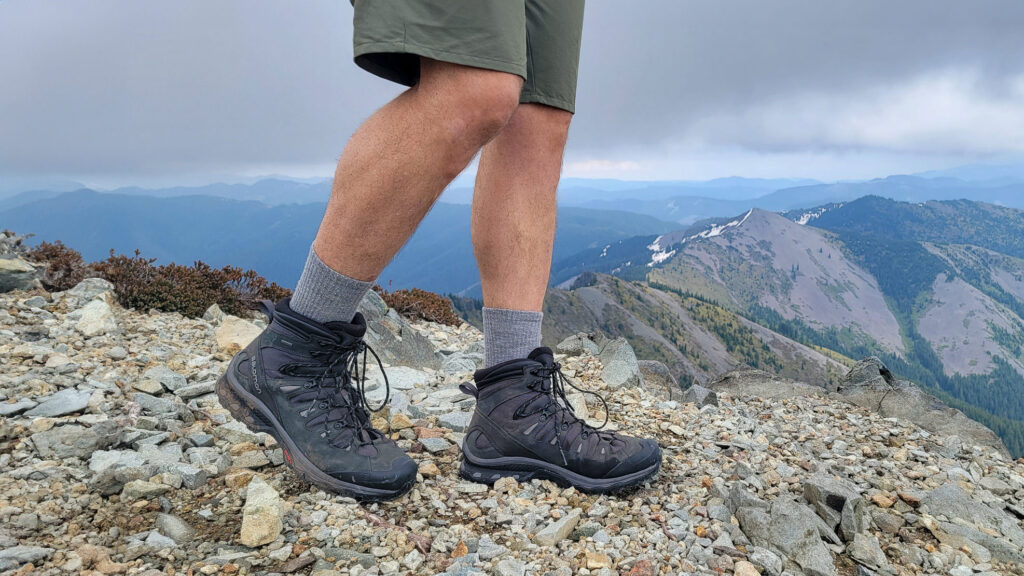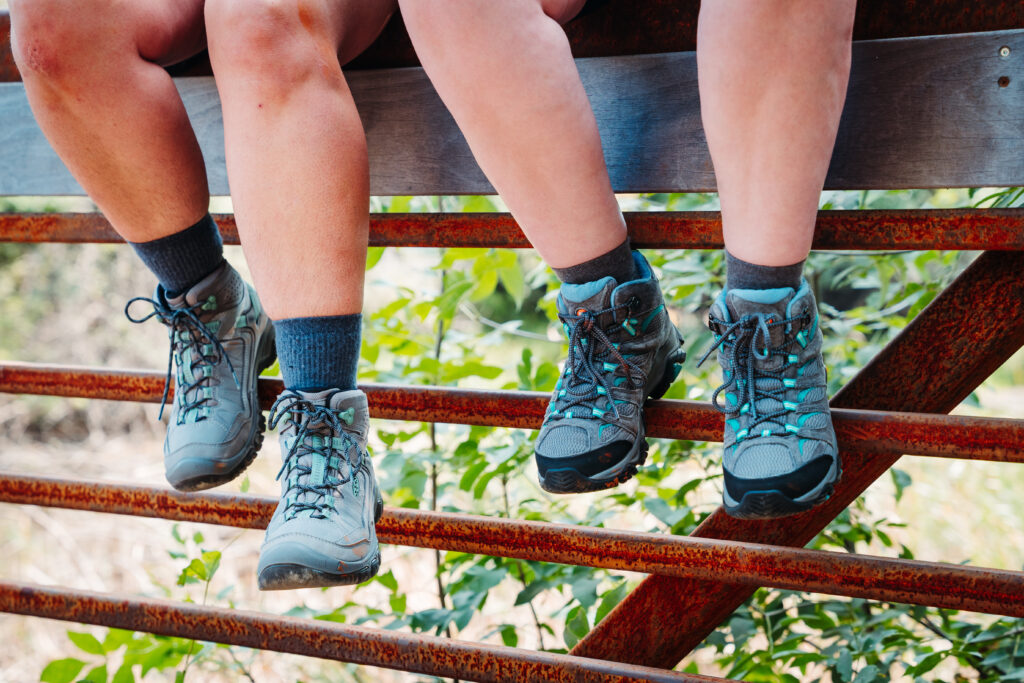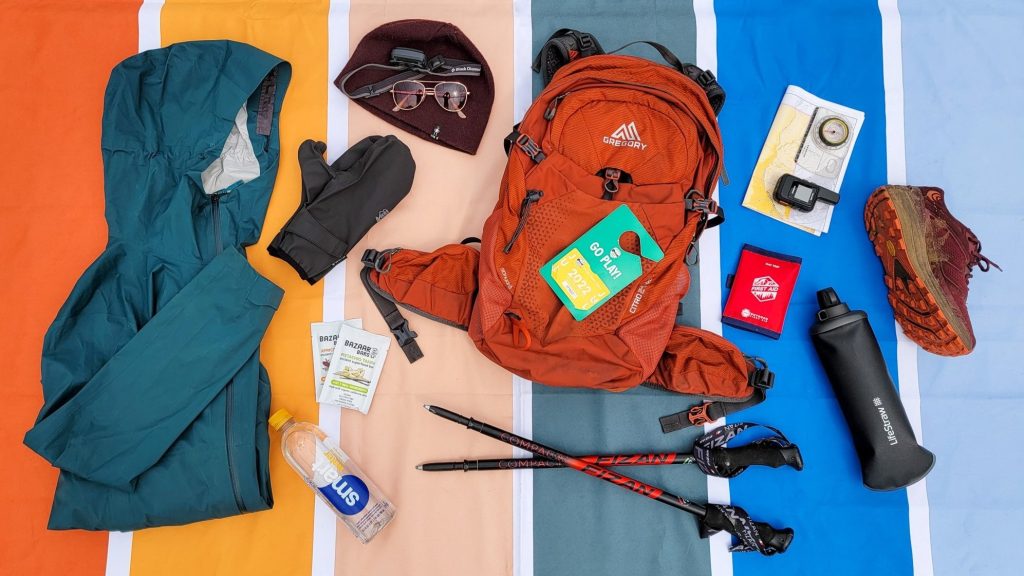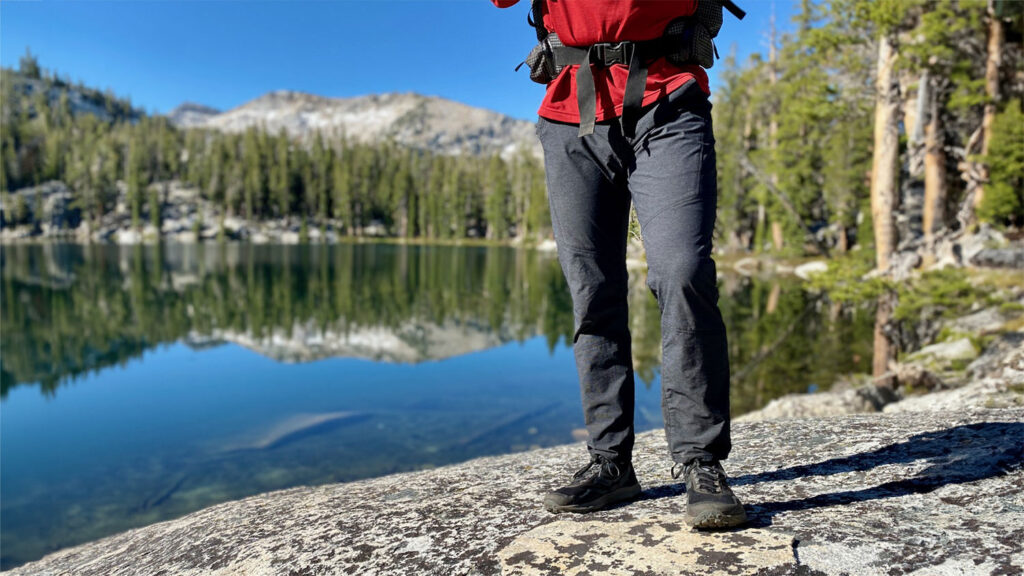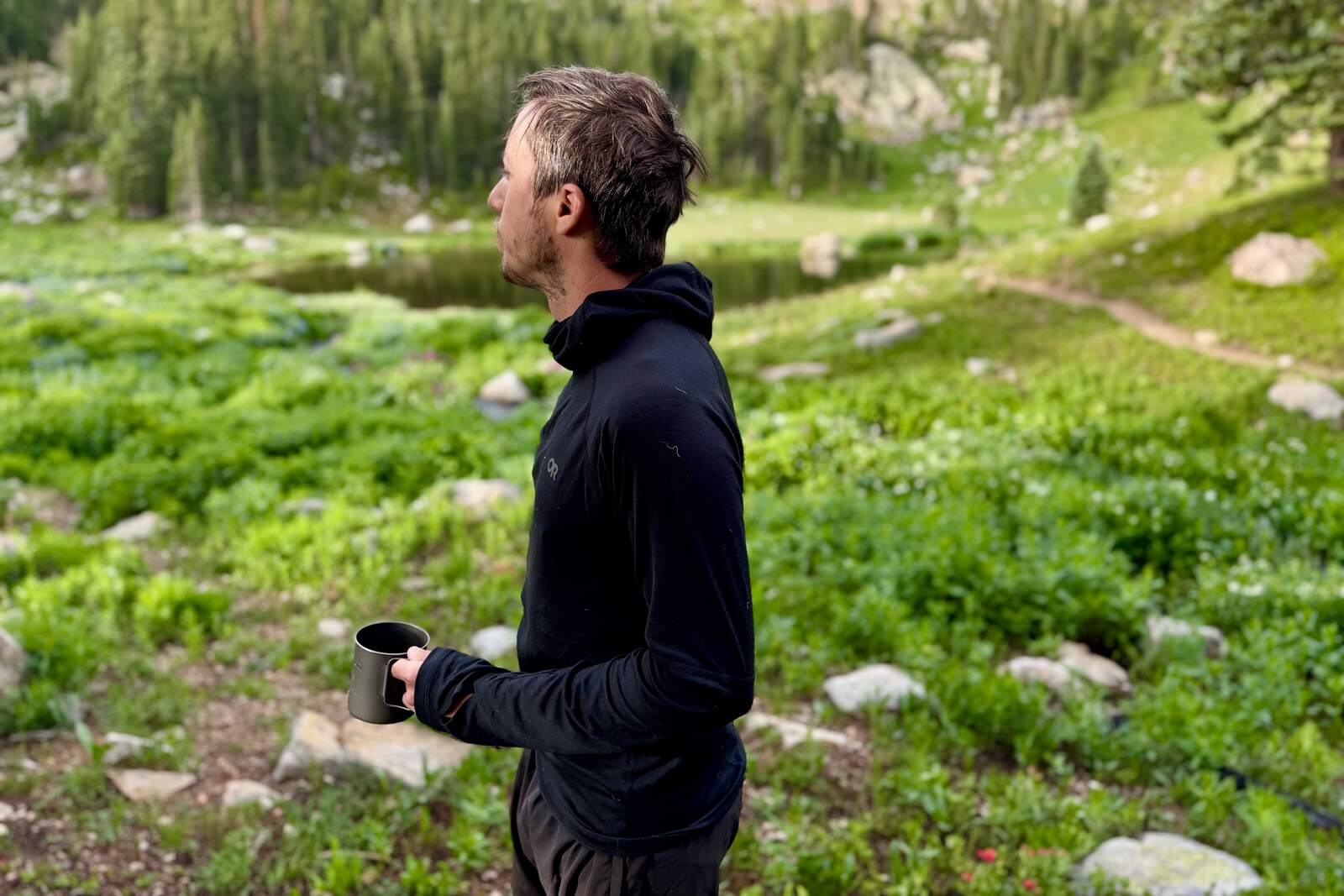
Base layers are essential to an outdoor clothing system. When you need to regulate your temperature and manage moisture in the blazing heat or blizzards, base layers are the first line of defense. We’ve rigorously researched 30 sets and tested the nine most promising options side-by-side to provide this review of the best base layers available.
After thousands of days and nights on trail, we know which ones are the warmest, lightest, most breathable, most comfortable, and most versatile for a range of uses. Our favorite layers come from reputable brands such as Smartwool, Patagonia, Arc’teryx, REI, Icebreaker, Ortovox, Outdoor Research, Ibex, and Helly Hansen.
To complete your winter layering system, be sure to dive into our review of the best down jackets, fleeces, and winter coats for both men and women. If you have questions about layers, take a look at What to Wear Hiking for more details on how to create the perfect system.
And for more info, check out some of our other most popular gear guides:

Quick Picks for Base Layers
Check out this quick list of the best base layers, or continue scrolling to see our full list of favorites with in-depth reviews.
Best Overall Base Layer: Arc’teryx Rho LT Crew Men’s ($100) / Women’s ($100)
Best Budget Buy: REI Midweight Half Zip Men’s ($60) / Women’s ($60)
Breathable Cold Weather Base Layer: Smartwool Intraknit Thermal Men’s ($130) / Women’s ($45)
Best Hoodie: Outdoor Research Alpine Onset Merino 150 Hoodie Men’s ($119) / Women’s ($119)
Breathable Midweight Base Layer: Patagonia Capilene Midweight Crew Men’s ($75) / Women’s ($75)
Best Ultralight Base Layer: Ibex Woolies Pro Tech Crew Men’s ($115) / Women’s ($115)
Versatile Wool Base Layer: Icebreaker Merino 200 Oasis Men’s ($105) / Women’s ($105)
Best Warmth-to-Weight Ratio: Ortovox 185 Merino Rock’n’Wool Men’s ($110) / Women’s ($110)
Warmest Wool Base Layer: Smartwool Classic Thermal Men’s ($115) / Women’s ($115)
Best Lightweight Wool Base Layer: Smartwool Classic All-Season Men’s ($90) / Women’s ($90)
Most Affordable Base Layer: Helly Hansen Lifa Stripe Men’s ($45) / Women’s ($45)
What’s New
We tested three new base layers, retested the tried-and-true options, and selected a new overall winner.
- The Arc’Teryx Rho LT Crew outperformed the competition as the best overall base layer with its excellent warmth-to-weight ratio and moisture-managing properties.
- The Ibex Woolies Pro Tech Crew is an ultralight merino layer that keeps your pack weight to a bare minimum.
- We loved the hood and built-in balaclava of the Outdoor Research Alpine Onset Merino 150 Hoodie so much that we had to include it in our list of favorites.
Base Layers Overall Testing Scores
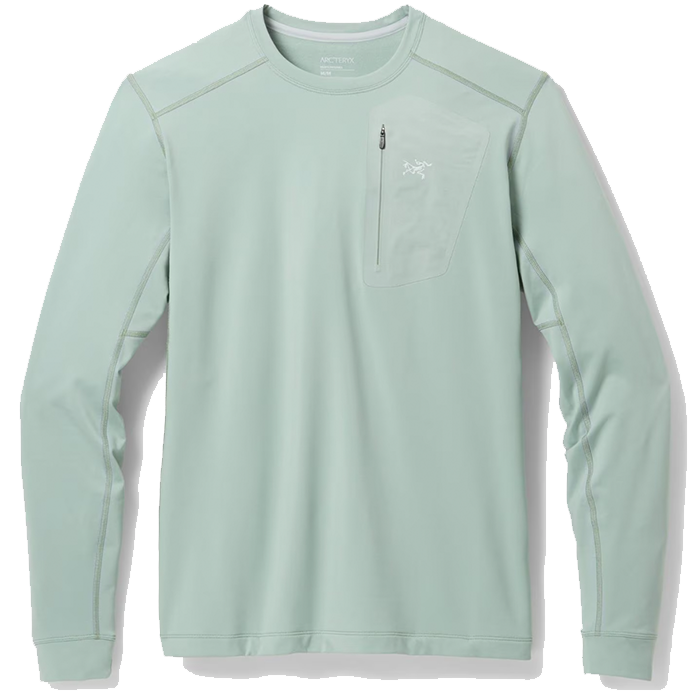
Arc’Teryx Rho LT Crew
Best Overall Base Layer
CleverHiker Rating: 4.8/5.0
Price: $100
Weight: 5.6 oz.(Men’s M)
Fabric/Weight: Midweight polyester + elastane
Pros
- Warm
- Ultra comfortable
- Excellent moisture management
- Breast pocket
Cons
- Too warm for some uses
- Pricey
The Arc’teryx Rho LT Crew (men’s/women’s) is our newest go-to for cold-weather pursuits. Made from brushed polyester fleece, it feels luxuriously soft against the skin, with a carefully tailored fit that balances snugness and relaxation. The articulated construction and stretchy fabric improve mobility, while the elastic wrists and classic crew neck add simplicity, durability, and easy layering.
Where the Rho LT Crew truly excels is in moisture management. It isn’t the most breathable choice, but it wicks moisture quickly and dries faster than many competitors. Its fibers easily spread moisture to the outside for efficient evaporation and dry surprisingly fast for a thick layer. Even when damp, it retains warmth remarkably well.
For you ultralight enthusiasts, the Rho LT Crew offers one of the best warmth-to-weight ratios we’ve seen. It remains minimal in features—no hood, zippers, or thumb loops—except for a small zippered chest pocket for tiny essentials.
For serious cold-weather adventurers, the Rho LT Crew is a smart investment. It’s perfect for cold, damp conditions, and while it’s too warm for tropical climates, it performs exceptionally well in alpine environments, shoulder seasons, or as part of a winter layering system. Although it’s priced higher than some, the performance and comfort it offers make it a strong choice for ultralighters, cold weather explorers, or anyone who runs cold.
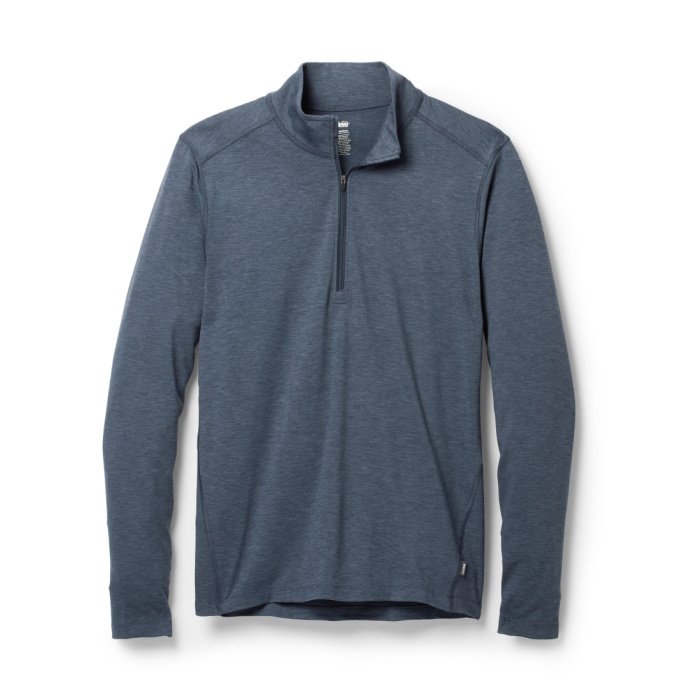
REI Midweight Half Zip
Best Budget Base Layer
CleverHiker Rating: 4.7/100
Price: $60
Weight: 9.8 oz.(Men’s M)
Fabric/Weight: Midweight polyester
Pros
- Affordable
- Durable
- Warm
- Comfortable
- Versatile
- Thumbholes
Cons
- Not odor resistant
- Heavier than most
Sometimes, you come across a budget option that performs just as well as higher-end items, which is certainly true with REI’s Midweight Half Zip base layer (men’s / women’s). This base layer is warm, durable, and comfy against the skin, and it’s become a staple in our layering system.
It’s on the heavy side compared to others, so we tend to only take it out in colder temperatures when we know we’ll be wearing it for most of our time outside. That said, the weight is still reasonable for packing it as a just-in-case item if you’re the type that likes to have an extra layer for sleeping on chilly nights. The zipper and fit make it a supremely layerable option that can be used as either a warm base layer or a lightweight mid-layer.
Although the zipper allows you to dump some heat when you get a little steamy, this base layer isn’t as breathable or moisture-wicking as wool, so we wouldn’t recommend it as the best option for high-output activities. It also isn’t odor-resistant or coated with any antimicrobial treatment, so it’s best suited for short hikes or chilling at camp.
This top is durable enough for many seasons of use, making the already small price tag even more appealing. Its multi-season capability will fill in all the gaps where your lightweight and heavyweight base layers are lacking. If you’re in need of something warm, versatile, and well-built on a budget, this is your guy.

Smartwool Intraknit Thermal Merino
Breathable Cold Weather Base Layer
CleverHiker Rating: 4.7/5.0
Price: $130
Weight: 7.3 oz.(Men’s M)
Fabric/Weight: Midweight merino Wool + polyester + elastane
Pros
- High Tech
- Breathable
- Warm
- Comfortable
Cons
- Expensive
- Not Durable
The Smartwool Intraknit Thermal Merino Base Layer (men’s/women’s) is a high-performance winter base layer ideal for active adventures. The innovative design allows exceptional mobility, breathability, and thermal regulation during intense cold-weather pursuits.
The cornerstone of the Intraknit Thermal’s performance is its unique knit structure, which balances warmth and breathability through strategically placed mesh zones. Unlike traditional base layers that compromise between heat retention and ventilation, this layer makes no such concessions.
The merino wool and polyester blend provides natural odor resistance and moisture-wicking properties that keep you dry during high-output activities. We were particularly impressed by its warmth-to-weight ratio, which achieves some of the highest thermal efficiency of any layer we’ve tested. The slim, athletic fit, 3D mapping, and unique knit structures in the elbows, wrists, forearms, shoulders, and waist allow excellent mobility without constriction.
Despite its premium price point, the Intraknit Thermal isn’t trying to be a do-it-all base layer. It specializes in high-intensity winter activities, from trail running to winter camping. While it may not be the most durable layer, it absolutely excels in its intended environment.
For the active adventurer who refuses to let cold temperatures limit their outdoor pursuits, this is a great base layer with which to go the distance.
More: Smartwool Intraknit Thermal Merino Base Layer Full Review

Outdoor Research Alpine Onset Merino 150 Hoodie
Best Hoodie
CleverHiker Rating: 4.5/5.0
Price: $119
Weight: 7.8 oz.(Men’s M)
Fabric/Weight: Midweight merino wool + polyester + elastane
Pros
- Warm
- Thumb holes
- Hoodie and balaclava
- Versatile
Cons
- Hood isn’t always practical
- Not the fastest drying
The Outdoor Research Alpine Onset Merino 150 Hoodie (men’s/women’s) is a feature-rich, versatile base layer designed for chilly-weather performance and harsh conditions.
The Outdoor Research Alpine Onset Merino 150 Hoodie is a feature-rich, versatile base layer designed for chilly-weather performance and harsh conditions.
Made from non-mulesed 150gsm merino wool, it provides a solid balance of warmth, breathability, and comfort. While the wool is mildly itchy, typical of new merino, the flat seams, extended torso, and raglan sleeves enhance overall comfort and mobility. The longer fit layers especially well under outerwear.
The glaring, standout feature of this hoodie is its three-panel hood with a built-in balaclava, providing ample coverage, extra protection from the elements, and noticeable added warmth. Unfortunately, the design can bunch awkwardly at the neck when not in use.
The thumb holes are another welcome addition that further the layer’s practicality for skiing, backpacking, or sleeping in chilly temps.
Moisture management is solid, with impressive wicking for a wool layer, but breathability and drying speed are average. It’s not ideal for humid or high-output activities, though it performs admirably in moderate to cold conditions.
While it may be on the pricier side, the Alpine Onset Hoodie delivers excellent value with its handy features and durable construction. It’s best suited for those seeking a 3.5-season base layer that can double as a built-in ski mask or extra layer of warmth without needing additional accessories. For adventurers who prioritize efficiency, coverage, and warmth in variable conditions, this hoodie is a smart investment.
More: Outdoor Research Alpine Onset Merino 150 Hoodie Base Layer Full Review
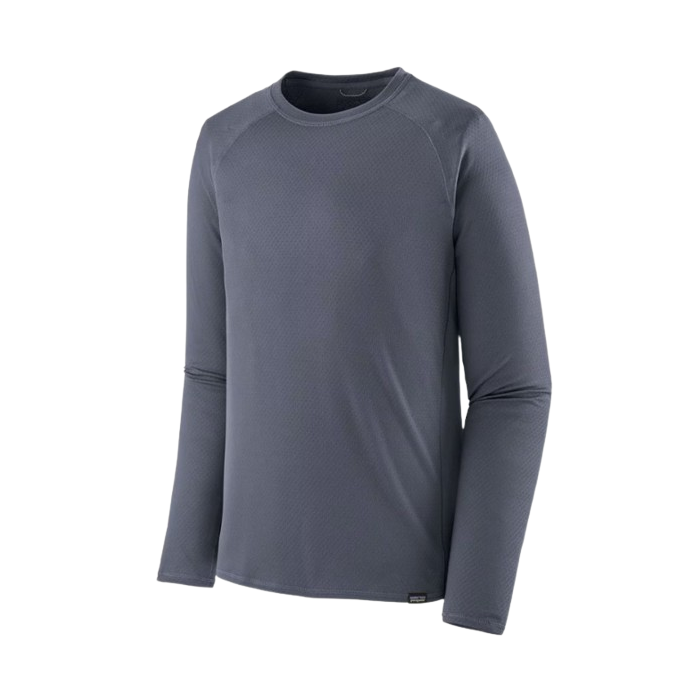
Patagonia Capilene Midweight Crew
Breathable Midweight Base Layer
CleverHiker Rating: 4.5/5.0
Price: $89
Weight: 6.2 oz.(Men’s M)
Fabric/Weight: Midweight polyester
Pros
- Affordable
- Durable
- Comfortable
- Easy to layer
Cons
- Not as warm or odor-resistant as wool
The Patagonia Capilene Midweight (men’s / women’s) is a durable and comfortable base layer top that’s quite a steal at its price point. We’ve used this top for multiple thru-hikes, and it’s still going strong nearly a decade later.
Patagonia’s proprietary Capilene blend is the softest, stretchiest, and best at wicking moisture of all the synthetic materials we’ve tested. While it doesn’t trap heat quite as efficiently as some wool base layers, the Capilene Midweight top is still highly versatile and easy to layer. It lays flat under mid-layers and doesn’t tend to wedgy with lots of movement. The fully gusseted underarms and stretchy fabric move with you and provide full mobility. We also appreciate the minimalist thumb loops, which help keep the sleeves in place when layering or delayering.
Compared to wool, the Capilene Midweight’s recycled polyester is more durable, stretchier, and packs down smaller. Although it’s not as antimicrobial as wool, Patagonia’s HeiQ Fresh odor control treatment does a good job of masking smells.
This top hits the sweet spot between warmth and breathability, making it a practical option all year round. During shoulder seasons, we often hike in this shirt by itself since it’s breathable and provides just the right amount of insulation for temperatures above freezing.
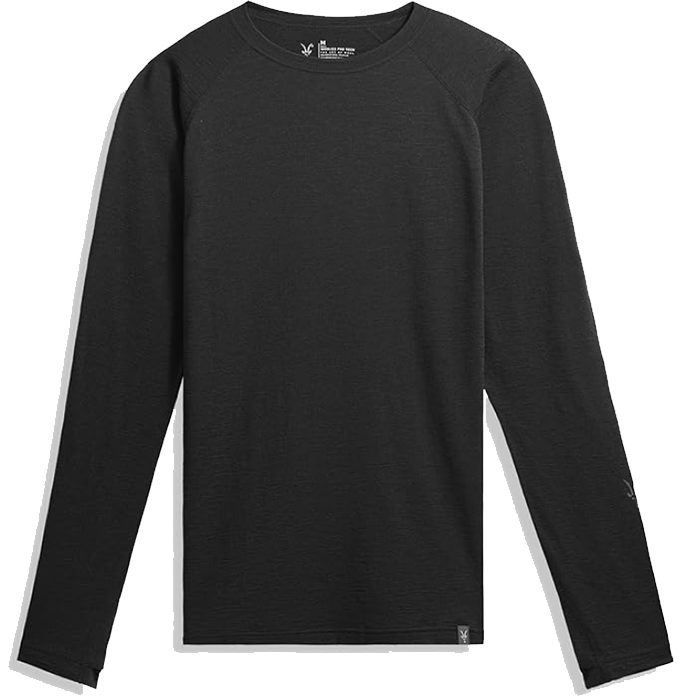
Ibex Woolies Pro Tech
Best Ultralight Base Layer
CleverHiker Rating: 4.5/5.0
Price: $115
Weight: 4.2 oz.(Men’s M)
Fabric/Weight: Lightweight merino wool + nylon
Pros
- Ultralight
- Increased durability and elasticity for wool
- Comfortable
- Stretchy
Cons
- Not very warm
The Ibex Woolies Pro Tech Crew (men’s/women’s) is a lightweight, mobility-oriented base layer built for high-output activities in cool weather. Unlike many wool layers, it provides surprising comfort right out of the box, thanks to a merino-nylon blend that reduces the usual itchiness of thin wool. Flatlock seams, raglan sleeves, and gusseted underarms improve comfort and mobility, while the stretchy fabric moves naturally with your body. The fit offers a true next-to-skin feel, so size up if you prefer a more relaxed fit.
Its drying time and moisture-wicking are solid, but what really stands out is its breathability. The semi-transparent fabric excels in situations where you want just a bit of insulation without overheating, like early morning climbs or summer backpacking in high-altitude terrain. It keeps you cool enough while moving and warm enough when resting.
Warmth isn’t this layer’s strong suit, and it’s not supposed to be. It shines in scenarios where minimal insulation is enough—like ski touring, desert hiking, or humid environments where breathability is more important than bulk. It’s too thin for cold-weather backpacking unless you add extra layers.
Feature-wise, the Pro Tech keeps it simple: a crew neck, long torso, and well-made thumb holes. It also comes in a quarter-zip version.
Ultimately, the Ibex Woolies Pro Tech isn’t for everyone. It’s not a do-it-all option, and it comes at a premium price. But for warm-weather adventurers, ultralight backpackers, or anyone chasing fast-and-light performance, this base layer fills a valuable—and highly breathable—niche.
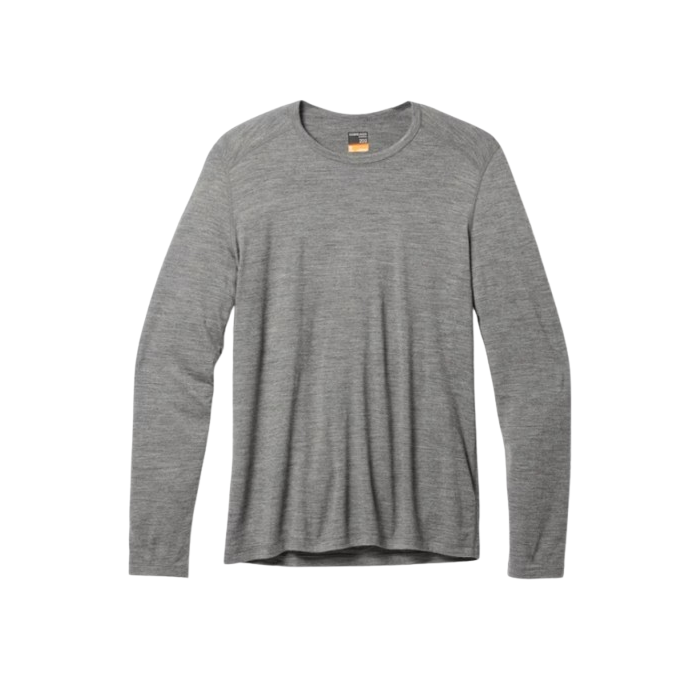
Icebreaker Merino 200 Oasis Long-Sleeve Crewe Thermal Top
Versatile Wool Base Layer
CleverHiker Rating: 4.5/5.0
Price: $105
Weight: 7.6 oz.(Men’s M)
Fabric/Weight: Midweight merino wool
Pros
- Odor-resistant
- Comfortable
- Breathable
- Packs down small
- Versatile
- Moisture wicking
Cons
- A little pricey
- Not as durable as some
The Icebreaker Merino 200 Oasis (men’s / women’s) was our choice as a hiking and sleeping base layer over 500 miles on the Colorado Trail. It’s versatile, 100% merino wool, a touch warmer and more comfortable than comparable options. This top does a great job filling the gap between ultralight wool base layers and medium to heavy base and mid layers.
This fabric weight is 200g/ms, adding a little more warmth than similar base layers while sacrificing a hair of breathability and drying time. However, because of merino wool’s natural moisture wicking, sweat is quickly dispersed to the outer layers of the fabric to avoid evaporative cooling. The added bonus of naturally odor-resistant wool makes it ideal for multi-day trips with lots of activity. Wool is known to be less durable than synthetic materials, but the slightly heavier fabric weight of the Oasis 200 will last a bit longer than thinner wool options.
The wool feels soft against the skin, and the flatlock seams aren’t perceivable at all. We did notice a little bit of scrunching when we layered the top and moved around, but it was minor and certainly not a deal breaker.
The Merino 200 Oasis features a comfortable fit with gusseted underarms for added mobility and a slightly looser crew neck. Icebreaker provides ample colorways, but its pajama-like appearance isn’t the best option for casual wear.
More: Icebreaker Merino Oasis 200 Base Layer Review Full Review
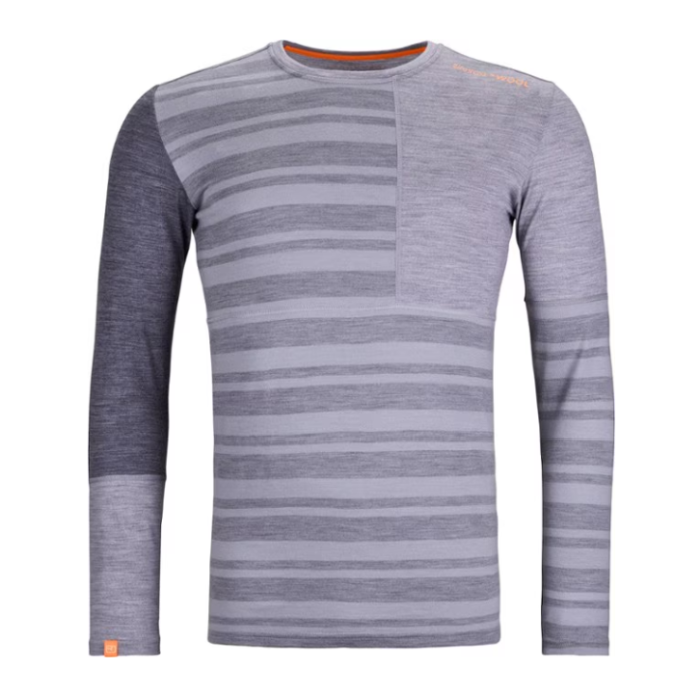
Ortovox 185 Rock’n’Wool
Best Warmth-to-Weight for Wool
CleverHiker Rating: 4.5/5.0
Price: $110
Weight: 6.6 oz.(Men’s M)
Fabric/Weight: Midweight merino wool
Pros
- Excellent warmth-to-weight
- Odor-resistant
- Athletic fit
- Moisture wicking
Cons
- Style might not appeal to some
- Tends to wedgie
If you’re looking for something that will keep you warm without weighing down your pack, the Ortovox 185 Merino Rock’n’Wool base layer (men’s / women’s) balances warmth and weight. At 6.6 ounces, it falls in the lightweight base layer range, but its warmth performs like a midweight base layer.
The merino wool, which can be itchy on some garments, is actually remarkably smooth on this layer. The fine inner material feels soft against the skin, and the snug fit feels like a cozy hug. Because of its athletic fit, this top can sometimes “wedgie” underneath other fitted layers during heavy activity.
This top benefits from all of merino wool’s natural characteristics of excellent moisture wicking, temperature regulation, and odor resistance. It’s a great choice for winter camping when you’ll be wearing the same base layers for days on end without changing. Due to its thickness, it’s not quite as breathable as other wool base layers and won’t pack down as small as synthetic tops.
The Rock’n’Wool comes in four different colors that all feature a split, asymmetrical design that is meant to signify the multi-faceted nature of all your outdoor adventures. While the designs are unique, they don’t scream casual wear and might not be appealing for everyone and every occasion.
Although it’s a little pricier, we think the Ortovox 185 Merino Rock’n’Wool base layer is one of the most versatile options on our list, making it worth every penny.
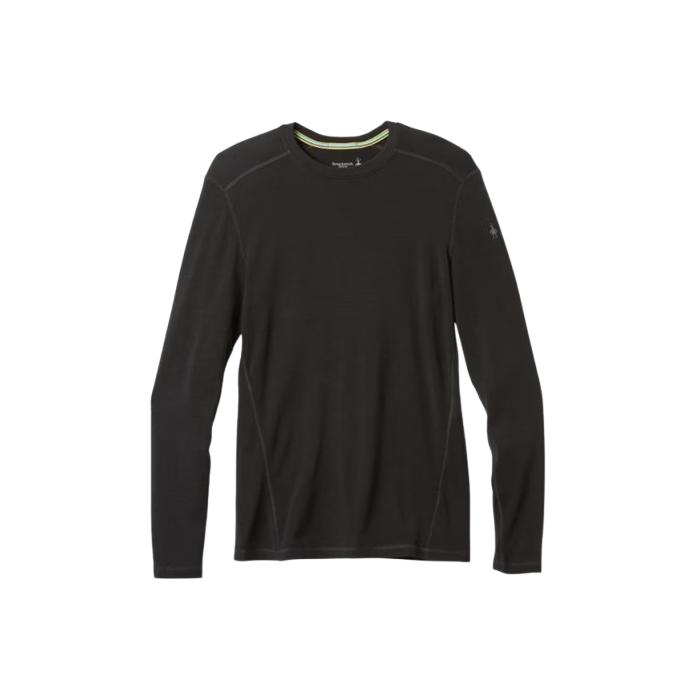
Smartwool Classic Thermal
Warmest Wool Base Layer
CleverHiker Rating: 4.5/5.0
Price: $120
Weight: 10.3 oz.(Men’s M)
Fabric/Weight: Midweight merino wool
Pros
- Warm
- Lots of color options
- Soft
- Odor-resistant
- Great moisture wicking
Cons
- Expensive
- Not as versatile as others
- Not the most breathable
The Smartwool Classic Thermal (men’s / women’s) is a warm and cozy base layer ideal for fall to spring. The Thermal is just the right thickness to help you thermoregulate in chilly fall and winter conditions. It is also available in a quarter-zip option with the added ability to dump excess heat buildup.
As a 100% merino wool base layer, the Thermal does an excellent job at wicking away moisture. While it wasn’t the fastest drying material of all the layers we tested, the wool still insulates while it is wet and quickly wicks moisture away from your skin so your core can stay warm. The wool is also naturally odor-resistant, which makes it ideal for multi-day trips.
Although it performs best in colder months, the Thermal can be used as a base layer or a mid-layer. The Interlock-knit wool is soft against the skin, and the flatlock seams are not noticeable. As a mid-layer, the shirt has enough extra fabric to be worn over a tighter-fitting base layer.
We give this top a lot of style points. The relaxed fit looks great as a standalone layer for lounging at camp or casual apres. Smartwool offers this shirt in a ton of different color waves to ensure that there is something for everyone.
The Classic Thermal is a little pricier, but its solid construction and premium fabrics make it well worth it.
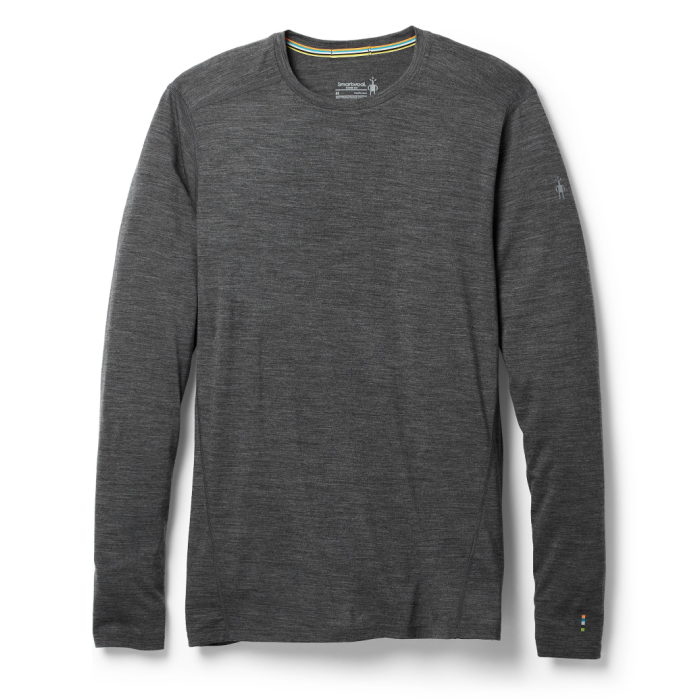
Smartwool Classic All-Season
Most Affordable Merino Wool
CleverHiker Rating: 4.4/5.0
Price: $90
Weight: 6.5 oz.(Men’s M)
Fabric/Weight: Lightweight merino wool + nylon
Pros
- Breathable
- Dries quickly
- Good warmth-to-weight
- Odor-resistant
Cons
- Lightweight material doesn't last as long
- A little itchy at first
- Noticeable seams
The Smartwool Classic All-Season base layer (men’s / women’s) is one of our favorites all year round. We found it is the right thermal weight for most summer camping trips. It’s thin and breathable for when the sun is out but also a cozy base layer for cool nights in the 50s. During our dry speed tests, this top performed among the best. It even dried out quicker than some 100% merino wool layers.
The fabric is an 88% merino wool and 12% nylon blend that weaves in the advantages of both natural and synthetic fibers. The naturally odor-resistant wool sits against your skin, wicking moisture away and helping with fast dry times, while the nylon core adds durability and elasticity. While the fabric is drying, the insulating wool layer keeps you warm even when the top is a little wet.
We like the relaxed fit of the Classic All-Season, but we found it to be a little itchier than some of the other layers we tested. The seams are a bit noticeable against the skin as well, and it can tend to bunch up under lots of layers during increased activity. However, the pajama-like fit is comforting and makes this layer a great option for sleeping or hanging in camp.
For ultralight backpacking, this is a great lightweight top. It’s warm at night, breathes well, and is only 6.5 ounces. Though the thin material is a little less durable in the long run, and some of the lighter women’s colors are semi-see-through, this is still an excellent option for cool (but not cold) summer backpacking trips.
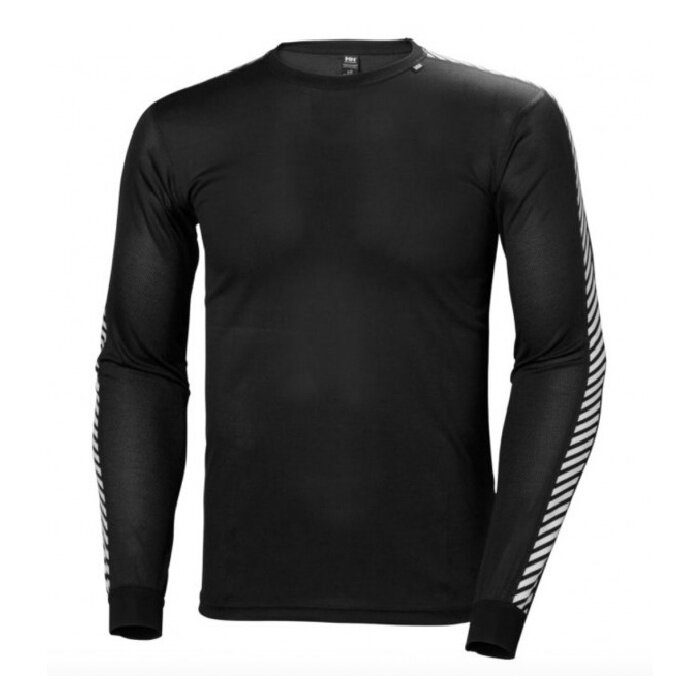
Helly Hansen Lifa Stripe Crew
Most Affordable Base Layer
CleverHiker Rating: 4.2/5.0
Price: $45
Weight: 4.8 oz.(Men’s M)
Fabric/Weight: Lightweight polyester + polypropylene
Pros
- Affordable
- Quick-drying
- Athletic fit
- Ultralight
- Very breathable
Cons
- Not odor-resistant
- Not as warm as others
- Runs small
- Not as versatile as others
The Helly Hansen Lifa Stripe Crew base layer (men’s / women’s) is the lightest, most breathable, and most affordable base layer we tested. Helly Hansen’s proprietary Lifa Dry material excels at moisture wicking and dries very quickly, making it a great choice for high-output activities. The fully synthetic material is also very stretchy, so the fabric moves with you when you’re on the go. This top features a low-profile, athletic fit that does run a bit on the small size. We recommend sizing up one size with this base layer.
This base layer isn’t as warm as others on our list, but the fit and flatlock seams make it comfortable for layering under other clothing. It’s also designed with flat, fitted cuffs that work nicely under gloves. The Lifa Crew is optimal for trail running, backpacking, and cross-country skiing since it has just the right amount of insulation for active days.
The Lifa Stripe Crew is the lightest base layer we tested by about a half ounce, making it perfect for ultralight backpacking. We love it for brisk mornings on trail as much as cozying up for dinner and a sunset. If you get it sweaty, it dries quickly enough to be a warm shirt to sleep in as well. However, the synthetic material doesn’t have the natural odor-resistant qualities of wool, so it will start to stink over time.
The racing stripes on the sleeves are a unique look, but it might not be everyone’s cup of tea. We wouldn’t call it the most stylish standalone base layer, but this isn’t a deal breaker for us since it’s activewear and will usually be under another layer.
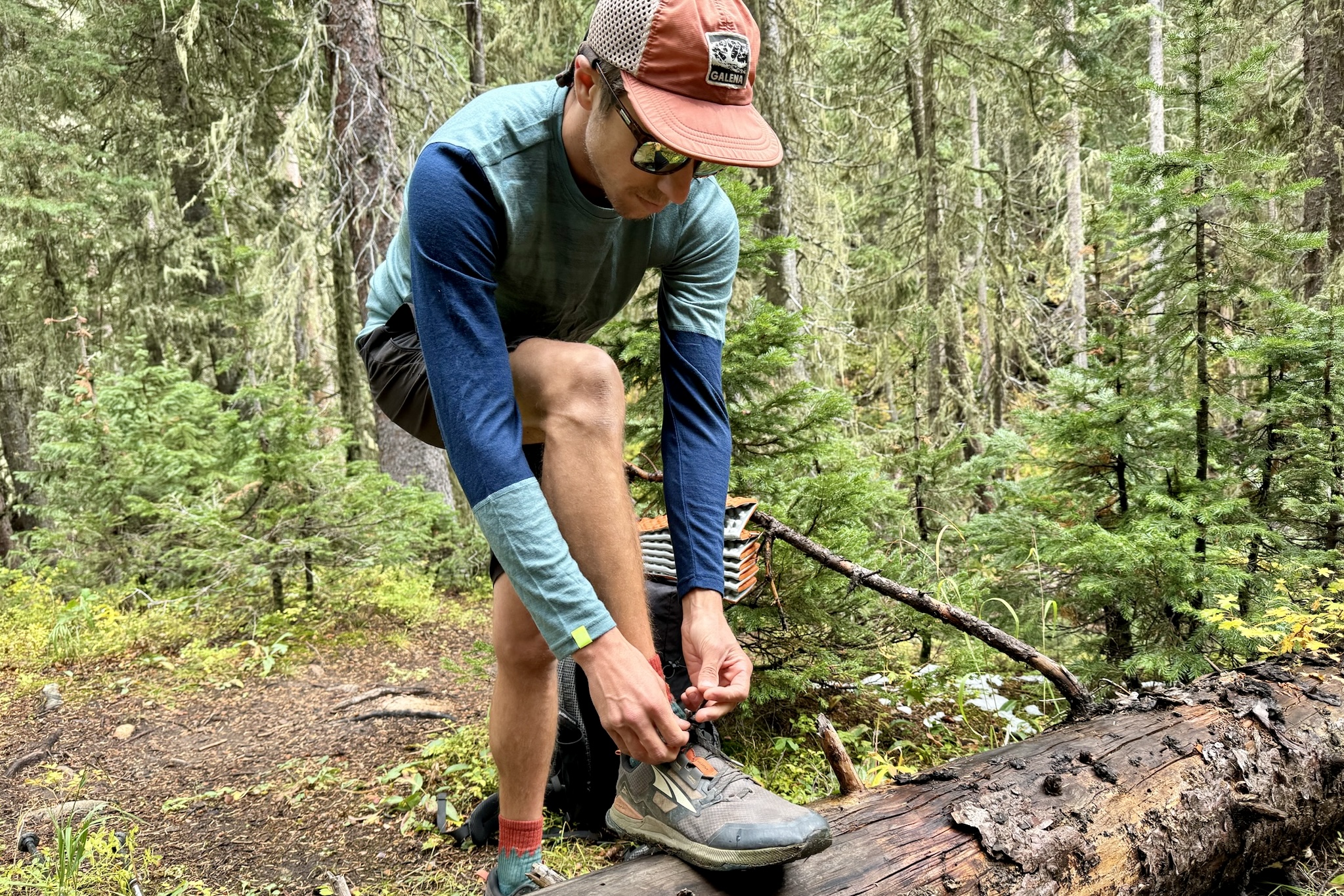
Product Comparison Table
| oSort | Product | Price | Weight | Fabric/Weight | Fit | Comfort | Moisture Control | Warmth | Features & Versatility | 0 |
Arc’Teryx Rho LT Crew View Men's View Women's |
$100 | 5.6 oz. (Men’s M) | Midweight polyester + elastane | Crew | 5.0 | 4.8 | 4.9 | 4.5 | 1 |
REI Midweight Half Zip View Men's View Women's |
$60 | 9.8 oz. (Men’s M) | Midweight polyester | Half Zip | 4.6 | 4.5 | 4.8 | 4.8 | 2 |
Smartwool Intraknit Thermal Merino View Men's View Women's |
$130 | 7.3 oz. (Men’s M) | Midweight merino Wool + polyester + elastane | Crew | 4.7 | 4.7 | 4.8 | 4.5 | 3 |
Outdoor Research Alpine Onset Merino 150 Hoodie View Men's View Women's |
$119 | 7.8 oz. (Men’s M) | Midweight merino wool + polyester + elastane | Hoodie | 4.2 | 4.4 | 4.6 | 4.8 | 4 |
Patagonia Capilene Midweight Crew View Men's View Women's |
$89 | 6.2 oz. (Men’s M) | Midweight polyester | Crew | 4.4 | 4.6 | 4.3 | 4.5 | 5 |
Ibex Woolies Pro Tech View Men's View Women's |
$115 | 4.2 oz. (Men’s M) | Lightweight merino wool + nylon | Crew (also available in half zip) | 4.5 | 4.8 | 4.2 | 4.3 | 6 |
Icebreaker Merino 200 Oasis Long-Sleeve Crewe Thermal Top View Men's View Women's |
$105 | 7.6 oz. (Men’s M) | Midweight merino wool | Crew | 4.4 | 4.7 | 4.4 | 4.3 | 7 |
Ortovox 185 Rock’n’Wool View Men's View Women's |
$110 | 6.6 oz. (Men’s M) | Midweight merino wool | Crew | 4.6 | 4.4 | 4.7 | 4.2 | 8 |
Smartwool Classic Thermal View Men's View Women's |
$120 | 10.3 oz. (Men’s M) | Midweight merino wool | Crew | 4.3 | 4.7 | 4.9 | 4.1 | 9 |
Smartwool Classic All-Season View Men's View Women's |
$90 | 6.5 oz. (Men’s M) | Lightweight merino wool + nylon | Crew | 4.2 | 4.7 | 4.2 | 4.3 | 10 |
Helly Hansen Lifa Stripe Crew View Men's View Women's |
$45 | 4.8 oz. (Men’s M) | Lightweight polyester + polypropylene | Crew | 3.9 | 4.8 | 4.1 | 3.9 |
|---|
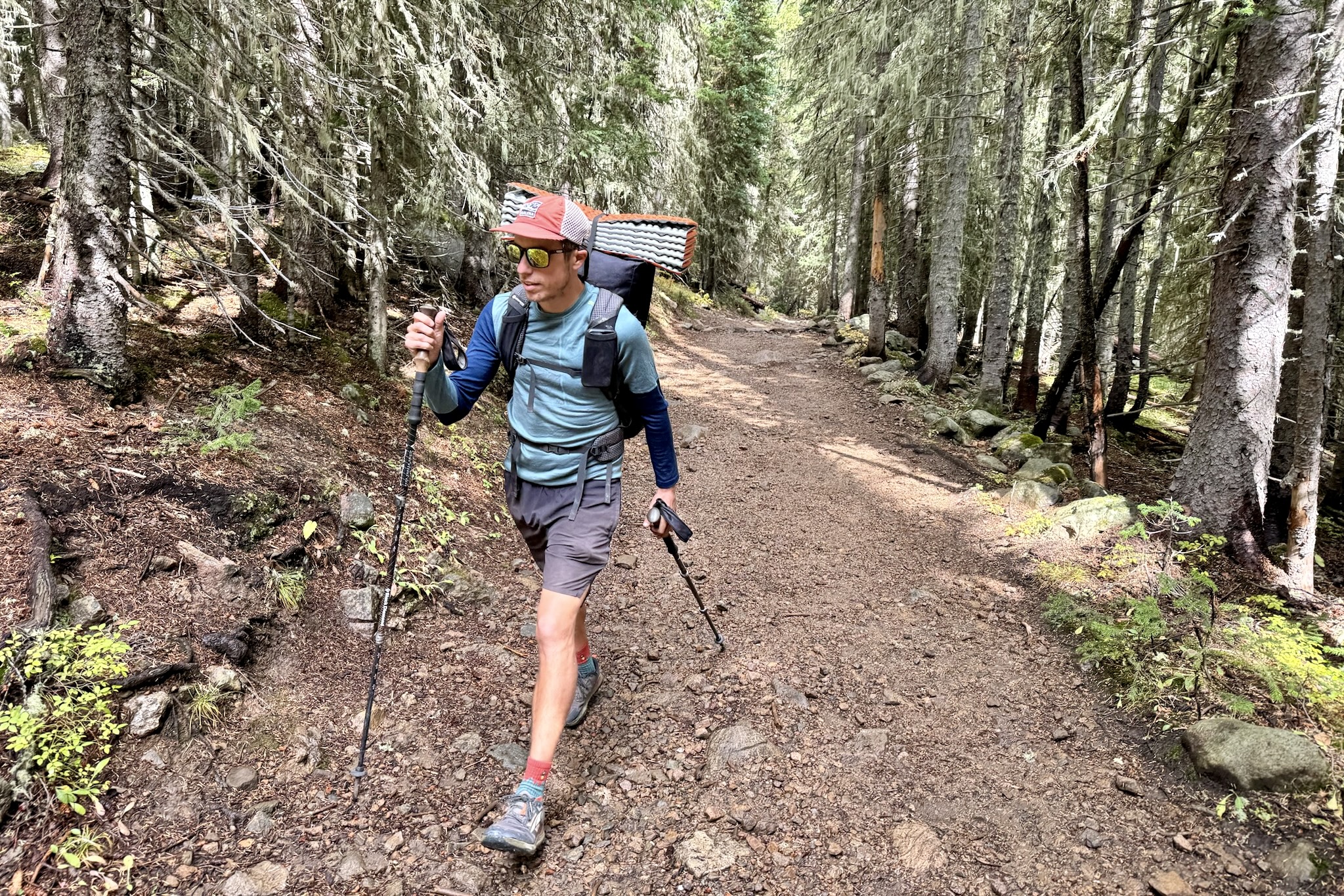
How We Test & Methodology
Our team of backcountry experts thoroughly tests each base layer in a wide range of scenarios to determine the most comfortable, versatile, breathable, warmest, and even the most stylish. We’ve put each layer through practical use over hundreds of miles of trail and weeks in the backcountry, from high alpine ridges to humid forests. We combine this practical experience with our expert industry knowledge and testing in a controlled environment.
COMFORT
We regard comfort as the most important metric because if it isn’t comfortable, you won’t wear it. While it’s inherently a subjective experience, we do our best to gauge a layer’s overall comfort in ways that everyone can understand.
We wear the layer against bare skin and layer it underneath and on top of other pieces. We note whether it feels soft or itchy, if the seams are noticeable, and if it lays flat. We then wear it as part of a complete layering system and perform some twists, a little yoga—anything to make it bunch up. All these observations combine into a comprehensive comfort score that reflects its performance in real-world conditions.
MOISTURE MANAGEMENT
Moisture management is essential in a base layer because staying dry directly affects comfort, warmth, and performance. We assess this using three key factors: moisture-wicking, drying time, and breathability.
To test wicking, we sprayed water onto each fabric and measured how quickly the wet area spread — a good indicator of how well sweat is pulled away from the skin.
For drying time, we weighed the water-saturated layers at set intervals to track how fast they lost moisture. Faster drying helps prevent the chill that can result from damp layers.
Breathability, though harder to measure, was judged through active wear — noting how breathable each base layer felt and how easily it released water vapor.
WARMTH
Warmth can be a tricky quality to assess in base layers because the environment is always changing, making controlled tests nearly impossible. As a result, most of our understanding of warmth comes from hours of real-world experience. We ski, hike, climb, lounge—anything to spend more time in each base layer.
Besides firsthand experience, product specifications also help determine warmth reliably. For instance, heavier fabrics are generally warmer than lighter ones, and materials like wool are naturally warmer than synthetics. We consider all these factors when rating each base layer’s warmth.
FEATURES & VERSATILITY
No base layer can do it all. Some excel at high-output activities, while others are better suited for hunkering down over a fishing hole. However, it’s definitely easier on the wallet when a piece of gear is more than a one-trick pony.
Many factors contribute to a layer’s versatility: how many seasons it’s suitable for, whether it can serve as a mid-layer, and if it has handy features like a neck zipper, pockets, thumbholes, or a hood. You’re much more likely to reach for a base layer often if it’s convenient to use and easy to incorporate into your layering system.
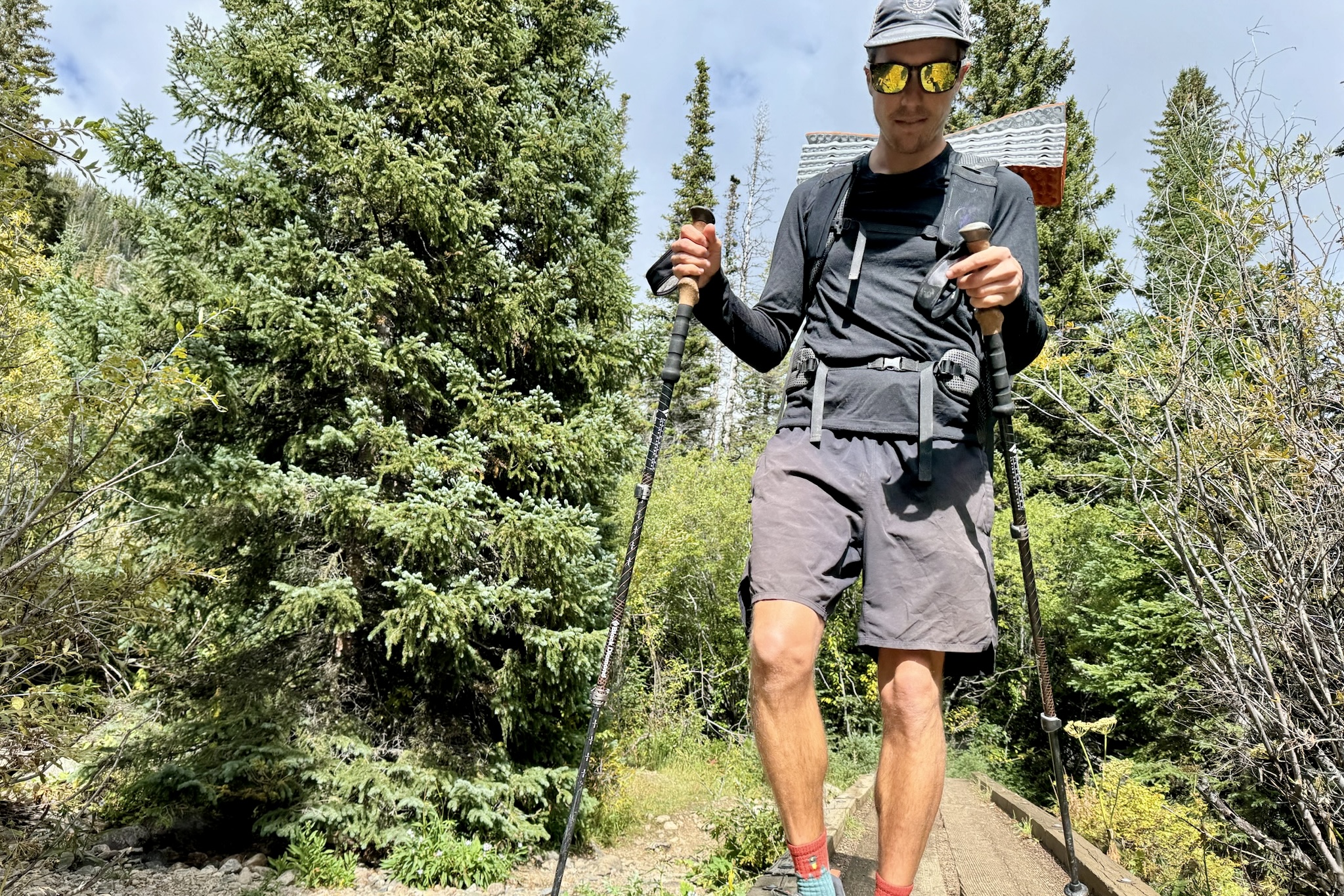
Why Trust CleverHiker
Every expedition calls for a specific type of layering system, and it takes a diverse range of experiences to perfect the art of layering.
Gear Analyst, Brett Kretzer, is an avid thru-hiker, rock climber, and snowboarder. He put a multitude of base layers to the test through thousands of miles on trail (including thru-hikes of the GR11, Colorado Trail, Long Trail, the Wonderland Trail, and more), hundreds of days on ski mountains, and a few seasons of backcountry splitboarding tours.
From thick, humid rainforests to frigid, sub-zero temperatures, Brett has put himself in a wide range of conditions that have taught him how to dial in his gear and clothing selection.
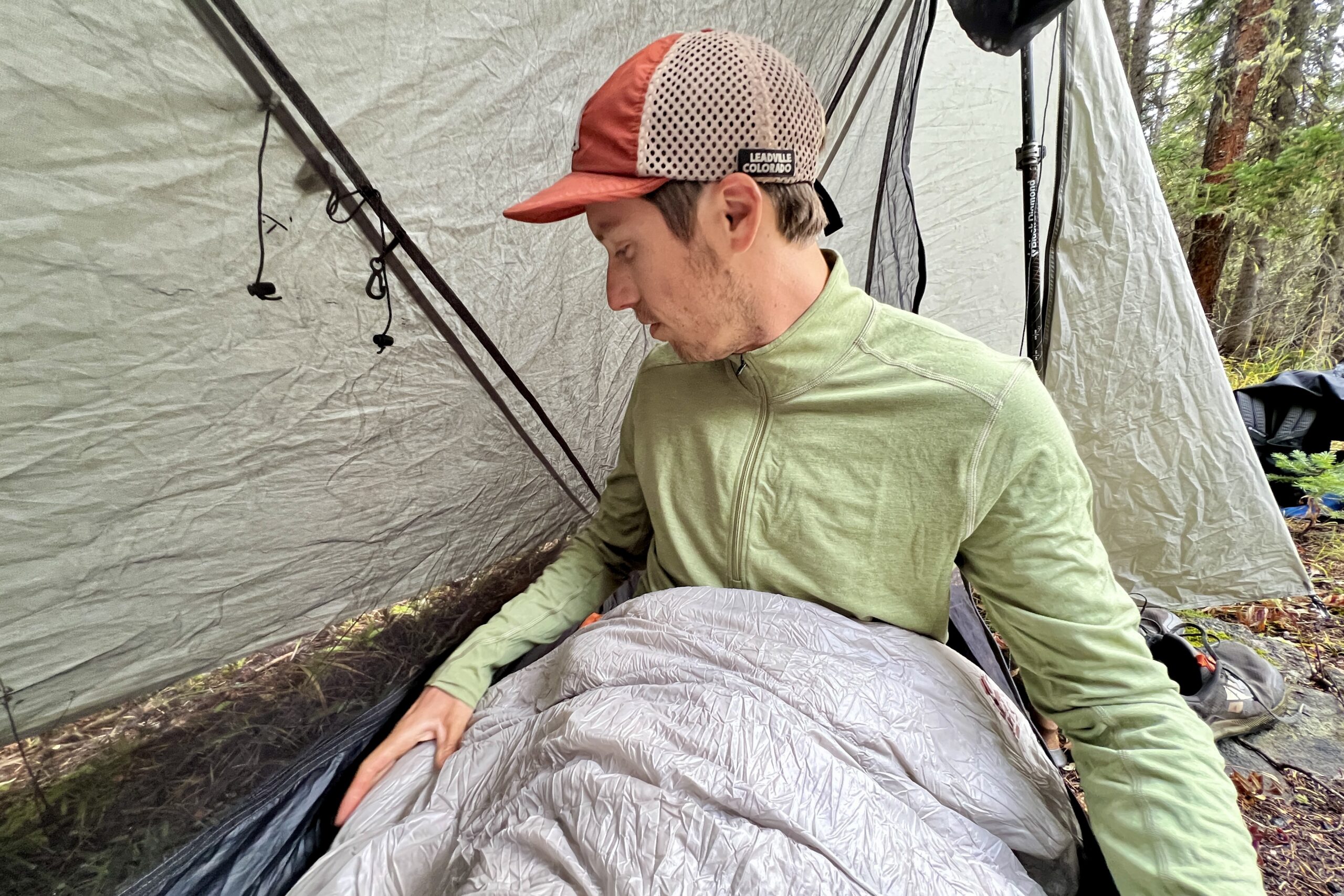
Analysis & Results
VALUE
It can seem unfair to compare base layers side by side given the different needs of activity, but we can get a general sense of a garment’s overall value by comparing its overall score across all dimensions to the price. The REI Midweight Half Zip impressed us with having the highest overall score as well as one of the lowest price tags. The Helly Hansen Lifa Stripe, on the other hand is the most affordable base layer we tested, but is targeted towards a very specific set of uses.
Not far behind in terms of overall value is the Arc’teryx Rho LT Crew. This base layer is surprisingly affordable for Arc’teryx, delivering top-tier performance at a mid-range price
If you’re looking to go slightly beyond the budget tier, the Smartwool Classic All-Season and Patagonia Capilene Midweight Crew are easy picks. They perform well and come from two of the most trusted names in outdoor apparel.
COMFORT
The comfort of a base layer is almost immediately noticeable when you put it on. Is it soft? Does it lay flat? Can you feel the seams? Wool can sometimes feel a little scratchy compared to synthetic fibers. Finally, flat and low-profile seams are much less noticeable on your skin than protruding ones.
With Arc’teryx’s reputation for supremely comfortable active wear, it’s no surprise that the Arc’teryx Rho LT Crew has earned the top spot in terms of comfort. The soft, brushed fleece and carefully tailored fit are hard to match.
For wool layers, we like the Smartwool Intraknit Thermal. It is an upgraded version of the Classic Thermal with a 3D mapping design that allows a little more freedom of movement.
Three equally ranked base layers that are worth noting for different reasons are the REI Midweight Half Zip, the Ortovox 185 Merino Rock’n’Wool, and the Ibex Woolies Pro Tech Crew. The REI Midweight Half Zip is the most comparable to the Arc’teryx in softness, while also providing excellent layerability. The fit of the REI serves a dual purpose – snug enough to fit under a fleece but loose enough to slide over a tight-fitting base layer.
The Ortovox 185 Merino Rock’n’Wool, while it tends to wedgie a little bit underneath other layers, is one of the softest pure wool layers we’ve experienced. Ortovox designed their wool to be as soft as any other fabric, with tiny, 19-micron fibers. This top also utilizes a unique construction that is both snug and athletic.
If you need something ultralight that’ll move with your body during strenuous and diverse aerobic activity, it’s tough to beat the Ibex Woolies Pro Tech Crew. The merino/nylon blend combined with Ibex’s innovative spinning techniques creates a fabric that is breathable and incredibly stretchy.
Base layers that scored a bit lower were mostly either a little itchy or didn’t layer as well, with a tendency to bunch up.
MOISTURE MANAGEMENT
Being trapped in a soggy base layer all day can be a very uncomfortable and even dangerous scenario which is why moisture management is such an important quality in active wear. The three ways fabric can manage moisture is through wicking, drying time, and breathability.
Synthetic fibers tend to have the best balance of these three abilities which is no surprise why the top three performers are the Arc’teryx Rho LT Crew, Helly Hansen Lifa Stripe Crew and Ibex Woolies Pro Tech Crew. The three however serve totally different purposes. The Rho LT is best for frigid winter adventures where insulation is crucial and sweating is inevitable. It won’t lose all of its water weight the quickest, but it will wick moisture away from your skin extremely efficiently so you can feel dry and warm even when you’re breaking a sweat. The Lifa Stripe on the other hand is the most breathable and quickest drying layer we tested, and therefore the best option for mitigating the chill on a fall run or an alpine start summit mission. The Ibex Woolies Pro Tech offers the best of both worlds with excellent mobility, drying time, breathability, and wicking, but not much warmth.
Clumped together with similar moisture-managing styles and capabilities are the Smartwool Classic All-Season, Smartwool Classic Thermal, Smartwool Intraknit Thermal, and the Icebreaker Merino Oasis 200 – all merino wool layers. They all benefit from merino wool’s natural anti-odor properties so you can squeeze a few more days out of each layer before tossing it in the washer. The Intraknit Thermal is one of the warmest layers on our list but enhances its breathability with built-in mesh zones in key areas.
A great synthetic counterpart to the Smartwool Classic All-Season is the Patagonia Capilene Midweight Crew. The Capilene is just as warm as the All-Season, but a tad less breathable. The fibers were more comfortable against the skin than the potentially itchy wool.
All of these layers are excellent choices for aerobic activity, and choosing between them depends on your intended use.
WARMTH
Warmth may seem like a one-way street, but we can’t discuss the warmest base layers without mentioning the lightest ones. The warmest base layer might be the best choice for climbing Mt. Kilimanjaro or hunkering down over an ice fishing hole, but it won’t be suitable for a long Nordic ski ascent.
That being said, the Arc’teryx Rho LT Crew and Smartwool Classic Thermal are the two warmest base layers on our list. The Rho LT, with its highly moisture-wicking synthetic fibers, helps keep you warm by staying dry. The thickness of the brushed fleece also offers plenty of insulation. The Classic Thermal, on the other hand, benefits from a snug fit and thick wool with excellent thermoregulating properties.
The next two in line are the Smartwool Intraknit Thermal and the REI Midweight Half Zip. The Intraknit Thermal is very similar to the Classic Thermal but includes polyester and elastane blended into the wool for added elasticity and breathability. The REI Midweight Half Zip provides extra warmth coverage for the neck and allows you to release excess heat through the zipper.
The Outdoor Research Alpine Onset Hoodie stands out solely for its built-in balaclava hood. It’s not the thickest layer on our list, but adding almost full coverage for the head and face definitely helps trap body heat.
Next to the Arc’teryx Rho LT, the Ortovox 185 Merino Rock’n’Wool showed the best warmth-to-weight ratio of all the base layers we tested. At just 6.6 ounces, it feels nearly as warm as layers weighing twice as much. Heat retention isn’t always a result of heavier fabric. The Rock’n’Wool’s warmth comes from the wool’s fineness, which is tightly knit and fits closely.
The Icebreaker Merino Oasis 200 strikes an excellent balance between weight, breathability, and warmth. Like the Rock’n’Wool, it falls into that ideal range with a fabric weight of about 185-200g/m². While the Rock’n’Wool is noticeably warmer, the Icebreaker has a more flowy fit and is slightly more breathable.
Finally, we owe a nod to the least warm layers on our list as well. The Helly Hansen Lifa Stripe Crew, Ibex Woolies Pro Tech Crew, Smartwool Classic All-Season, and Patagonia Midweight Capilene are all excellent options for when you just want to take the chill out of the air during shoulder seasons or on chilly mountain evenings.
FEATURES & VERSATILITY
We recognize that having a different base layer for each situation can get expensive, so we’ve rated each one’s versatility to find out which work best for multiple uses. In other words, we’ve done the research for you so you can get the most value. Some layers are practical for ten months of the year, while others are only suitable for a few seasons.
The one that we found to have the highest level of seasonal diversity is the REI Midweight Half Zip. It’s thick enough to keep you warm as a base layer in harsh winter conditions, but the zippered neck lets you dump excess heat when it gets too much during shoulder seasons. It works well in early spring and late fall as a standalone layer, eliminating the need for a mid-layer overall. Speaking of mid-layers, this REI top fits loosely enough to wear over a thinner base layer. The thumb loops are a nice bonus.
In terms of sheer amount of features, the Outdoor Research Alpine Onset Hoodie wins by far with its thumb loops and unique balaclava hood. With the Alpine Onset, you could potentially reduce your pack weight by leaving your beanie and buff at home. It’s easily one of our top three favorite ski layers.
The Patagonia Capilene Midweight Crew, Arc’teryx Rho LT Crew, and Smartwool Intraknit Thermal also offer excellent multi-season versatility. The Capilene strikes a perfect balance in fabric and weight, making it easy to incorporate into your layering system year-round. Depending on the conditions, you might need to add a mid-layer or a short sleeve, but the Capilene rarely feels unnecessary or out of place. The Rho LT Crew and Intraknit Thermal can also be worn year-round depending on the conditions, though they tend to be on the heavier side.
The most versatile layering setup includes two or three base layers to choose from, but if you only want one, one of these is your best option.
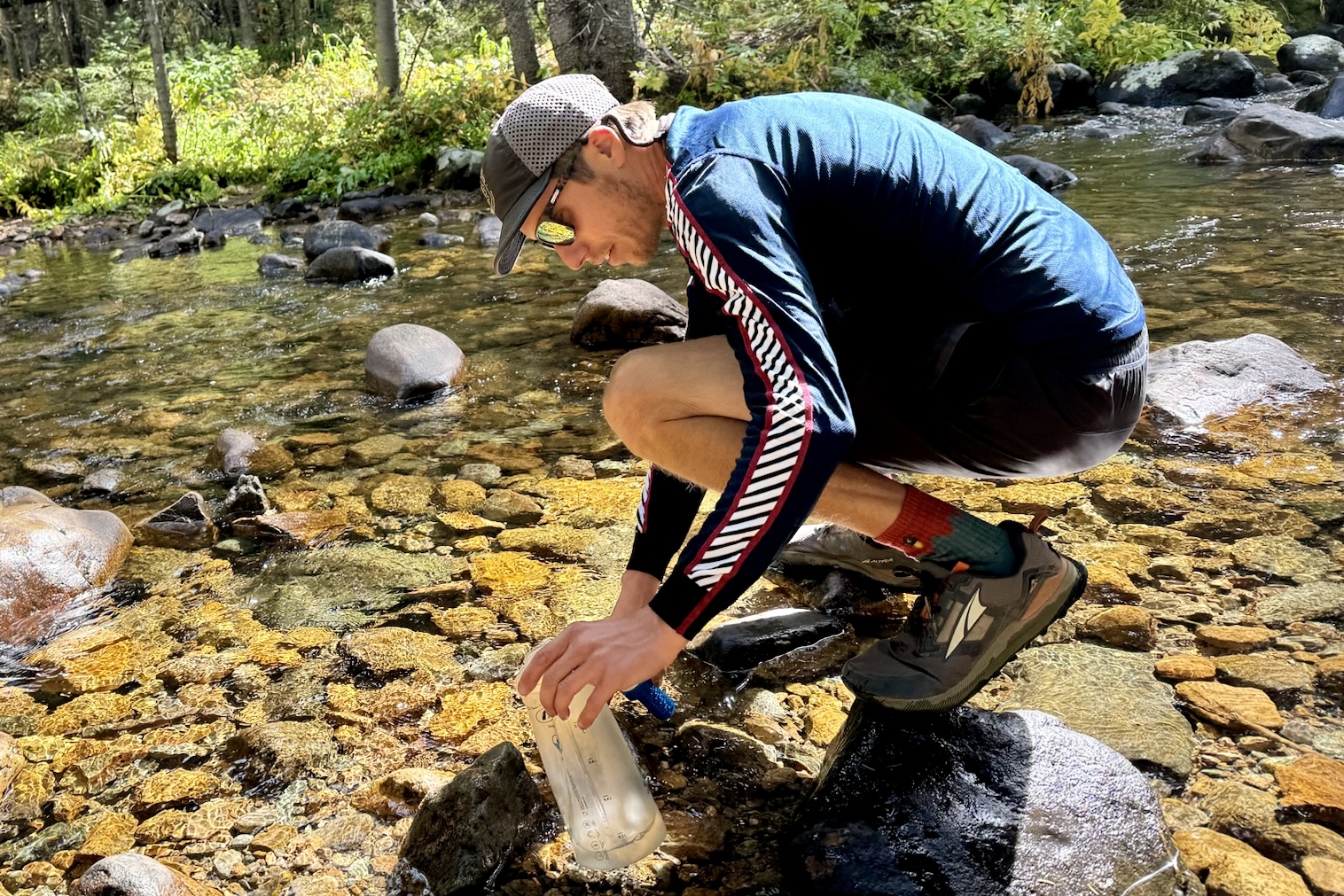
How to Choose a Base Layer
Choosing a base layer isn’t always straightforward, depending on how you plan to use it. Will you be ski touring during a multi-day hut trip or going on a chill fall backpacking trip full of leisure activities? Or maybe you’re heading out on a hunting trip where you’ll be hunkered down in a blind for hours at a time. Each scenario requires a different combination of material, warmth, breathability, and more.
MATERIAL
A base layer’s material can be a good indicator of how it will perform in various conditions. Below, we’ll detail some pros and cons of the most common base layer materials.
Wool
Wool tends to be more expensive than synthetic base layers, but it also has the best balance of heat efficiency, odor control, and moisture-wicking capability. Wool layers may not last as long as synthetic ones, and they tend to pill after washing and hold onto lint and pet hair. That said, if you use our technical fabric care tips below, you should still get plenty of use out of your wool clothing.
Polyester
Synthetic fabrics like polyester or nylon are durable, quick-drying, and excellent at moisture-wicking. We prefer synthetic shirts for their added breathability and typically more affordable prices. Synthetic layers don’t insulate as well as wool and need extra treatment to be anti-microbial. Still, they are much easier to care for and shouldn’t need replacing for many years.
Blends
Fabric blends with varying amounts of wool and synthetic fibers offer the best of both worlds. Synthetics are often added to improve wool’s elasticity and durability while keeping its natural benefits like odor resistance and thermoregulation.

MOISTURE MANAGEMENT
While a thick wool base layer does an excellent job at keeping you warm, if it doesn’t manage moisture effectively, it could risk your body going into hypothermia if it gets wet. In other words, moisture is harmful, and you should choose the layer that will keep you warm and dry based on the activities and conditions you expect.
Drying Time
Clearly, dry layers are the warmest and most comfortable, making drying time arguably the most important aspect of moisture management. However, when moisture gets trapped, it’s difficult or impossible for a base layer to dry completely, which is when other methods of moisture management become crucial.
Moisture Wicking
Moisture-wicking fibers quickly draw moisture away from your skin and toward the outer layers of fabric where it can evaporate without chilling your body. Polyester does an excellent job at this. The best moisture-wicking layers will feel dry on the inside even while they look soaked on the outside. This is an effective feature when an insulating layer and shell trap moisture pockets, preventing them from escaping.
Breathability
This one is a double-edged sword. On one hand, a breathable layer lets wind pass through the fabric to help with drying, while moisture can escape more easily. On the other hand, wind combined with moisture creates a chilling effect, just like your air conditioning unit at home. Breathability works best for active layers when you want to reduce the crispness in the air but don’t mind a little chill when you pause.
TIPS FOR LAYERING
Finding the perfect outdoor clothing layering system ultimately comes down to personal preference and the conditions you’re adventuring in. Check out our Hiking Clothing 101 article for some great tips to help you find what works for you.
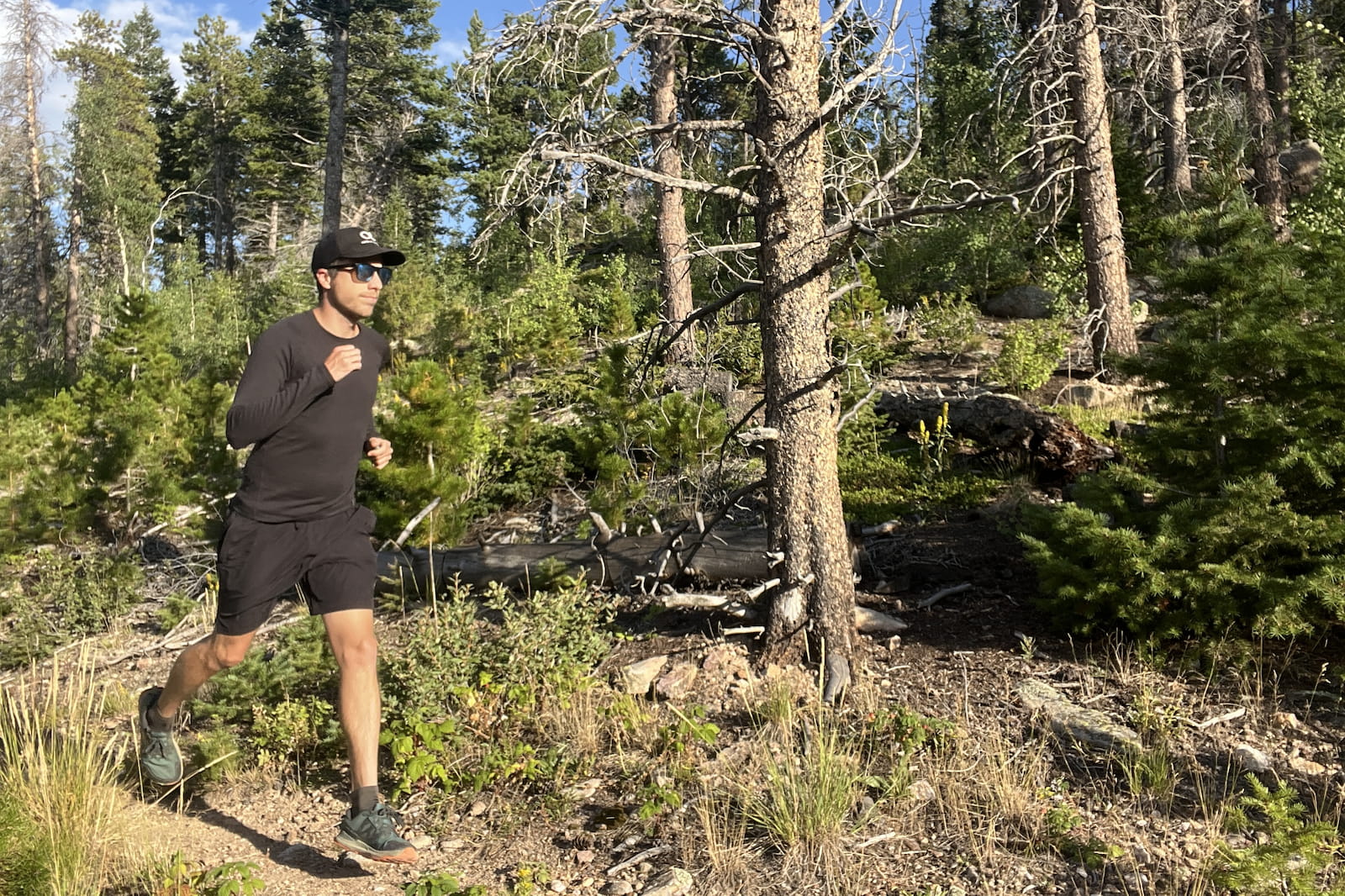
CARING FOR TECHNICAL FABRICS
Finding the perfect outdoor clothing layering system ultimately comes down to personal preference and the conditions you’re adventuring in. Check out our Hiking Clothing 101 article for some great tips to help you find what works for you.
- Use a front-loading washer – The agitator in a top-loading washer can snag zippers or drawstrings and be hard on delicate fabrics and seams. Make sure you zip all the zippers and tie the drawstrings before washing to prevent wear and tear.
- Use a technical fabric wash – We recommend Nikwax Tech Wash or Woolite for washing any technical fabrics because these solutions won’t leave fragrances or residue on your clothing.
- Only wash when you really need to – A lot of technical fabrics are designed to be antimicrobial and shouldn’t hold odors. Hiking clothing doesn’t necessarily need to be washed after every use.
- Don’t use fabric softener or dryer sheets – Fabric softener and dryer sheets can leave behind residue on the fabric and negatively affect performance by reducing breathability and insulation quality.
- Hang dry when possible – Heat and agitation in the dryer can damage technical fabrics, so it’s best to lay them flat or hang them on a line to dry naturally.
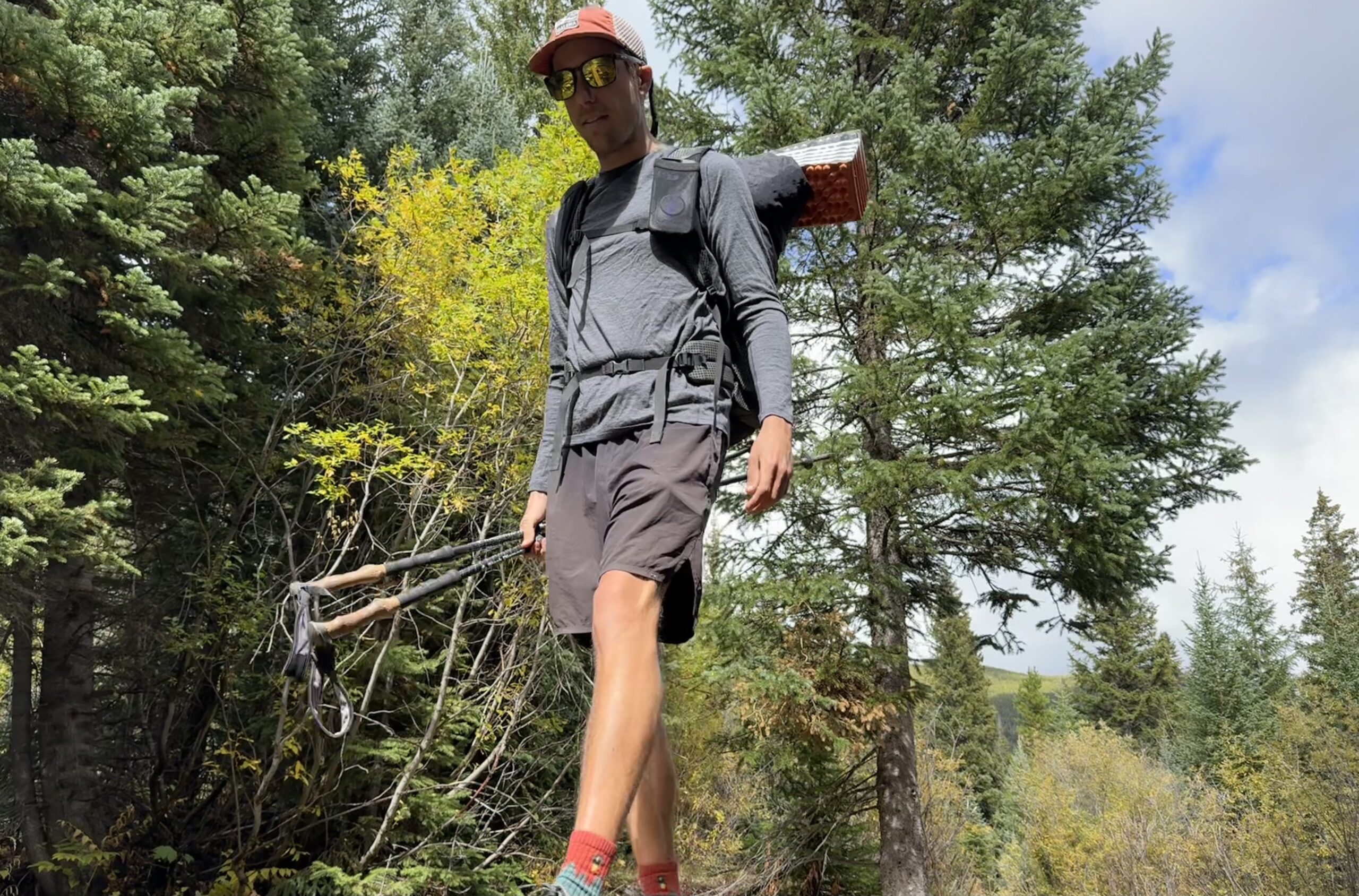
Conclusion
Whether packing for a glamping trip or preparing for an intense ski-mountaineering expedition, choosing the right base layer for the task at hand can make or break your experience. Depending on the situation, you might need warmth over breathability or versatility over comfort. Whatever the case, layering is truly an art. We hope we’ve provided valuable guidance and clarity to help you choose the perfect layers for all of your outdoor adventures.


